Best Revenue Recognition Software 2025: Top Solutions Compared
.jpg)
Revenue recognition has become one of the hardest problems in modern finance. ASC 606 and IFRS 15 lay out how revenue should be tracked and reported, but applying those rules at scale is challenging. [1] A single company can be dealing with multiple entities, subscription models, usage-based billing, and international contracts all at once, and each layer of complexity makes compliance harder. [2] Using manual processes means you fall behind quickly, and even legacy ERPs leave gaps that show up in reporting and audits.
In this review, we’re breaking down the leading revenue recognition tools on the market, comparing their strengths and highlighting where they fall short. Then we’ll show you how DualEntry’s AI-native ERP changes the game by automating compliance at the transaction level and giving finance teams real-time visibility across every entity.
Why Revenue Recognition Software Matters More Than Ever
Revenue recognition software has moved from a useful add-on to an essential part of modern finance. It touches compliance, close speed, and audit readiness all at once. [3] Teams are expected to close faster, apply ASC 606 and IFRS 15 consistently, and be ready to show clean numbers whenever an auditor asks.
The challenge grows bigger for SaaS companies and multi-entity groups. Subscription billing, usage-based pricing, and global subsidiaries can overwhelm even experienced finance teams. [8] A close that should be routine turns into a maze of adjustments and reconciliations. Each cycle carries the risk of errors compounding, and the margin for mistakes gets smaller every quarter.[9]
DualEntry was built specifically for these realities. Instead of retrofitting old ERP code to meet modern standards, it’s AI-native from the ground up. It automates compliance and gives finance teams real-time transaction visibility.
How to Choose the Right Revenue Recognition Software
Choosing revenue recognition software isn’t just about ticking a compliance box. The right system has to handle today’s standards and tomorrow’s complexity, without creating more manual work for finance. Here are the areas that matter most:
Standards support
Full ASC 606 and IFRS 15 coverage is non-negotiable. The software should manage contract obligations, variable consideration, allocation, and revenue timing automatically. If you find yourself building spreadsheets on the side to handle edge cases, the tool isn’t doing its job. [4]
Integrations
Revenue recognition doesn’t happen in isolation. The system needs clean connections with billing, CRM, and ERP data. Contracts, billing schedules, and usage records should flow in automatically. Every missing integration means another manual step, and another chance for errors to slip in. [6]
Disclosures
Audit teams expect a clear link from contract to revenue line item to disclosure note. Good software makes that trail easy to follow. The best systems produce disclosure-ready reports on demand, so finance doesn’t lose days chasing down reconciliations every quarter. [5]
Auditability + AI capabilities
While legacy tools can generate reports, modern platforms use AI to tag obligations, detect anomalies, and draft disclosure language in real time. That distinction matters. [7] It’s the gap between recording revenue in a system and being audit-ready at every moment.
Now let's compare the top revenue recognition software of 2025 and see how they look against the above criteria.
1. DualEntry
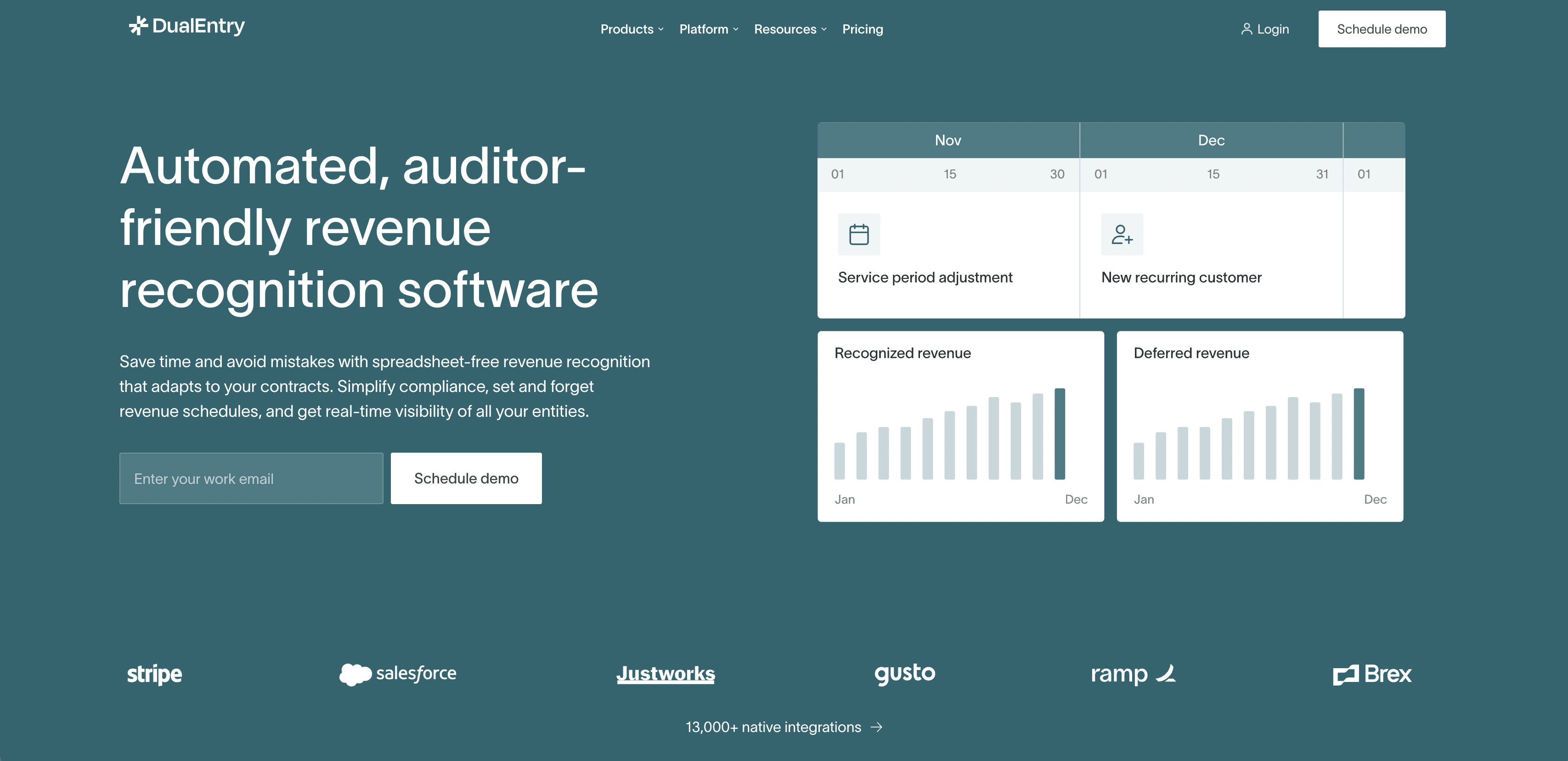
G2 rating: 4.8/5 (472)
DualEntry is built as an AI-native ERP – not a legacy system patched for compliance. Its revenue recognition engine is ideal for fast-growing companies managing complex contracts across multiple entities.
Instead of batch reconciliations at period-end, DualEntry automates revenue recognition at the transaction level. Every contract obligation, modification, and usage event is tagged in real time, so finance teams never lose track of compliance.
The platform is built for scale. Whether you’re adding entities, changing pricing models, or entering new markets, DualEntry keeps your reporting consistent without extra manual work. That means faster closes, cleaner audits, and better visibility for leadership.
Many CFOs highlight something simple but effective in their reviews: DualEntry doesn’t treat revenue recognition as a separate module. It’s connected directly into the ledger, billing, and reporting flow. That setup lowers risk, makes compliance checks quicker, and gives teams a clear view of what revenue is already recognized and what remains deferred.
Key Features
- End-to-end ASC 606 and IFRS 15 automation
- Contract obligation tagging with AI assistance
- Handles modifications, renewals, and usage-based models seamlessly
- Real-time audit trails with disclosure-ready reporting
- Native integration with billing, CRM, and financial workflows
- Multi-entity and multi-currency support out of the box
- Anomaly detection for compliance risks
- AI-driven forecasting for recognized and deferred revenue
Pros
- End-to-end automation of ASC 606 and IFRS 15 (no manual reconciliations at period end)
- Direct connection between revenue recognition, ledger, billing, and reporting layers
- Handles subscription changes, renewals, and usage-based models without breaking schedules
- Real-time audit trails and disclosure-ready reporting save time during audits
- AI anomaly detection and forecasting give finance leaders more visibility and peace of mind
- Multi-entity and multi-currency support is built in for global teams
- Implementation takes 24 hours
Cons / Risks
- Best suited for companies planning to scale
- Smaller teams may not use the full depth of features
- There may be a learning curve if you’re used to legacy systems or starter cloud systems
Pricing
DualEntry offers tailored pricing based on company size and complexity. Contact the team for a demo and custom quote.
2. Zenskar
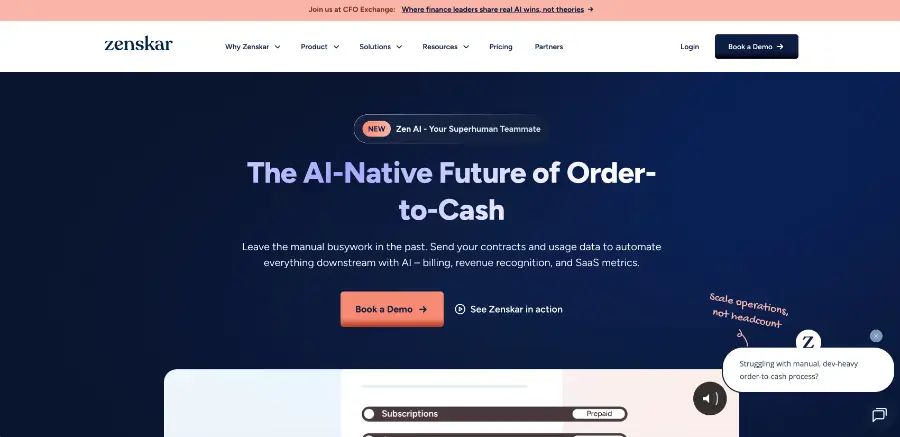
G2 Rating: 4.9/5 (77)
Zenskar is an AI-native order-to-cash system that automates billing, revenue recognition, collections, and SaaS revenue recognition metrics for modern finance teams.
It’s built to support complex pricing models without heavy engineering. Whether you’re handing subscriptions, usage-based plans or custom contracts, Zenskar can model them via a no-code visual builder.
Once a contract goes live, Zenskar takes over the heavy lifting. It identifies performance obligations, creates the required journal entries, and pushes them directly to the general ledger. From there, it keeps watch. If usage spikes, terms get amended, or variable consideration comes into play, the system updates the schedule automatically so the numbers stay accurate.
Finance teams like that they don’t have to rebuild revenue logic every time there’s a mid-contract modification or pricing change.
Key Features
- Full ASC 606 / IFRS 15 compliance, with performance obligations and revenue schedules
- No-code pricing & contract modeling (subscription, usage-based, hybrid, etc.)
- Audit trails with locked periods, detailed timestamps, versioning
- Real-time journal entry generation and ERP/GL sync
- Continuous monitoring & adjustment (variance detection, mid-contract updates)
- Multi-entity, multi-currency support
- Flexible revenue distribution and revenue recognition methods (straight-line, usage-based, custom)
- Strong integrations (100+ plug-and-play, CRM, ERP, etc.)
Pros
- Automation reduces manual effort significantly — billing, recognition, collections all handled within one flow
- Excellent integration with existing stacks (CRM, ERP, data layers)
- Flexibility to experiment with pricing, modify mid-contract without breaking the system
- Responsive support teams, especially during onboarding and troubleshooting
Cons / Risks
- There’s a learning curve – setting up very customized contracts takes attention
- Occasional minor bugs, though users say the support fixes them quickly
- Customization sometimes demands deeper configuration, and might require finance/ops investment up front
Pricing
Zenskar uses custom pricing tailored to company needs. There’s no flat public plan.
3. Tabs
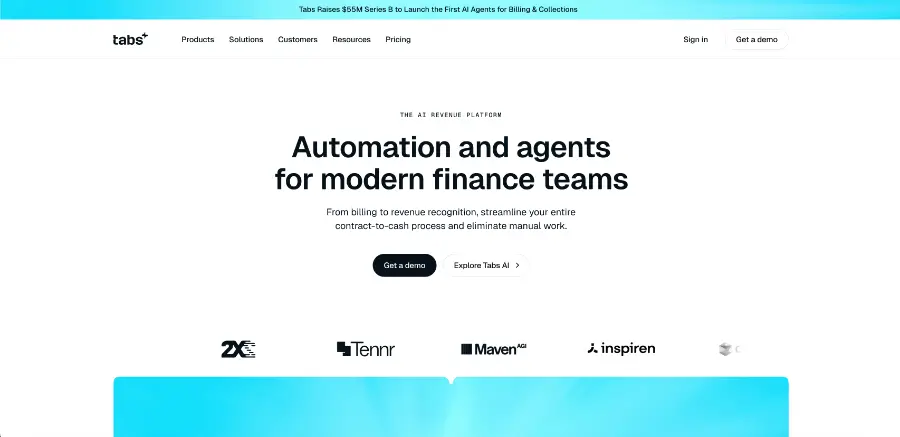
G2 Rating: 4.7 (48)
Tabs’ pitch: automate the full contract-to-close flow. Start with contract ingestion, spin into billing, and carry through to revenue recognition, all under one roof.
Once a contract is live, Tabs auto-generates invoices from the contract data and handles ASC 606 revenue recognition internally, with no spreadsheets required.
It also watches for changes, like usage surges, contract amendments, mixed billing models, and updates recognition accordingly.
Users appreciate how Tabs brings billing, collections, and recognition into a unified flow. It cuts down handoffs, accelerates cash flow, and gives clearer visibility into revenue status.
Key Features
- Automated ASC 606 / IFRS 15 revenue recognition based on contract + billing data
- Smart contract ingestion (so billing logic can flow from data without heavy manual setup)
- Support for subscription, usage-based, hybrid billing models
- Real-time dashboards showing invoiced, collected, and recognized revenue metrics
- Native integrations with CRM, ERP, and finance stacks
- Enterprise-grade security & audit controls (SOC 2, encryption, etc.)
- API layer and plug-and-play integrations
Pros
- Brings billing, recognition, and collections together in one platform
- Reduces manual handoffs and complexity in the revenue cycle
- Offers good visibility with real-time metrics and dashboards
- Has strong integration potential
Cons / Risks
- Because the platform handles many functions, setup can be heavier at the start
- Some edge cases or highly custom billing models may require extra configuration
- If parts of your tech stack are legacy or unusual, integration may require extra work
Pricing
Tabs offers custom pricing based on company size, contract volume, and billing complexity.
4. SAP S/4HANA Cloud
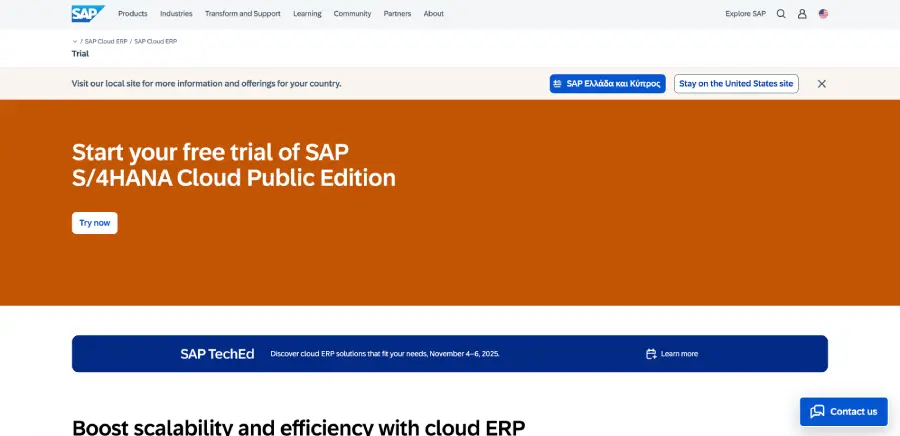
G2 Rating: 4.7 (822)
SAP S/4HANA Cloud offers a unified ERP platform with revenue and cost accounting capabilities built into the core. Its design lets you decouple invoicing from recognition so billing patterns don’t force your revenue accounting to twist.
Once a contract is live, S/4HANA Cloud can apply Universal Revenue Recognition (URR) or event-based / contract-based revenue recognition (CBRR) depending on your use case. The system also supports rules and events that trigger recognition independent of billing events.
For project-based or service contracts, S/4HANA allows you to define when and how performance obligations are met, including handling contract changes midstream.
Key Features
- Automated revenue and cost accounting integrated into ERP backbone
- Support for Universal Revenue Recognition and contract-based models
- Event-based triggers for recognition independent of billing
- Handling contract modifications, usage changes, and complex billing models
- Audit trails and financial transparency within SAP’s ecosystem
- Multi-entity and multi-currency support consistent with ERP core functions
Pros
- Deep ERP integration (ledger, finance, operations) gives consistency and reduces silos
- Powerful flexibility – billing and revenue recognition can be decoupled
- Scales to large, complex enterprises already using SAP infrastructure
Risks / Cons
- Complexity in configuration; getting the rules right usually requires heavy SAP expertise
- May be overkill (and costly) for smaller companies or lean tech stacks
- Custom or specialized models may push against its standard capabilities, requiring workarounds
Pricing
Pricing is custom, usually bundled as part of your SAP S/4HANA Cloud subscription and licensing.
5. Chargebee RevRec
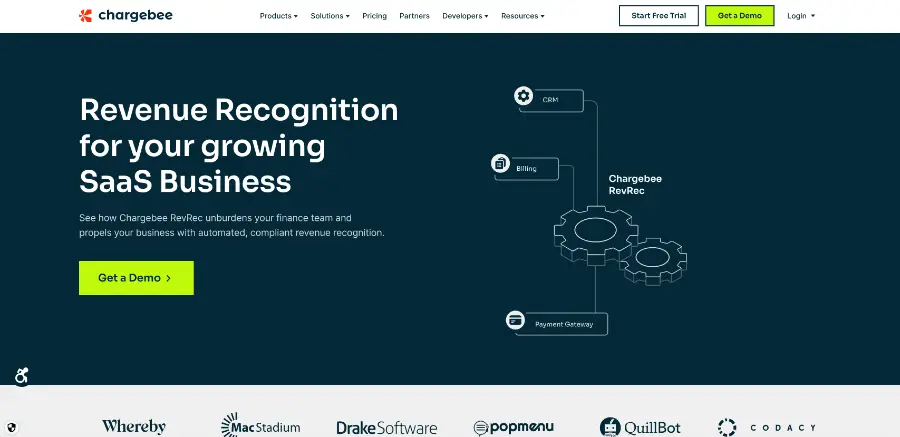
G2 Rating: 4.4/5 (918)
Chargebee RevRec is the revenue recognition engine built on top of Chargebee’s subscription and billing offering. It’s designed for SaaS businesses with monthly recurring revenue (MRR) that need to automate ASC 606 / IFRS 15 compliance without tearing apart their existing systems.
When a subscription or contract enters the system, RevRec starts by identifying the performance obligations and applying your revenue rules. It then creates the right journal entries and links them back to your general ledger.
Behind the scenes, the platform maintains a detailed revenue subledger. That view includes deferred revenue, recognized revenue, unbilled receivables, and contract costs. You can also set up different recognition methods for different products or contract types.
If a contract changes in the middle of its term (maybe usage goes up, a discount is added, or terms are amended) RevRec updates the schedule automatically. That adjustment keeps reporting accurate and reduces the manual clean-up work at the end of the period.
Key Features
- End-to-end automation of the ASC 606 / IFRS 15 five-step model
- Standalone Selling Price (SSP) library integrated with your price book
- Revenue subledger with detailed GL mapping and journal entry support
- Configurable revenue rules (ratable, point-in-time, proportional performance)
- Close period controls and validations before posting
- Multi-currency support and forex translation for global contracts
- Integration with billing, CRM, and accounting systems to sync contract and transaction data
Pros
- Strong automation reduces manual recognition and reconciliation work
- Tight coupling with subscription and billing flows simplifies end-to-end handling
- Flexible revenue rules allow product-level and contract-level customization
- Built-in audit trails and controls help with audit readiness
- Good visibility into deferred vs recognized revenue, and ability to explore deviations
Cons / Risks
- Some advanced features (e.g. deeper integrations or custom revenue rules) require higher-tier plans or more setup
- Overly complex contract logic might push the system toward configuration limits
- Since it’s built on top of Chargebee billing, if your billing setup is messy, RevRec can inherit those same issues
Pricing
Chargebee offers custom pricing for RevRec based on contract volume and complexity.
6. Sage Intacct
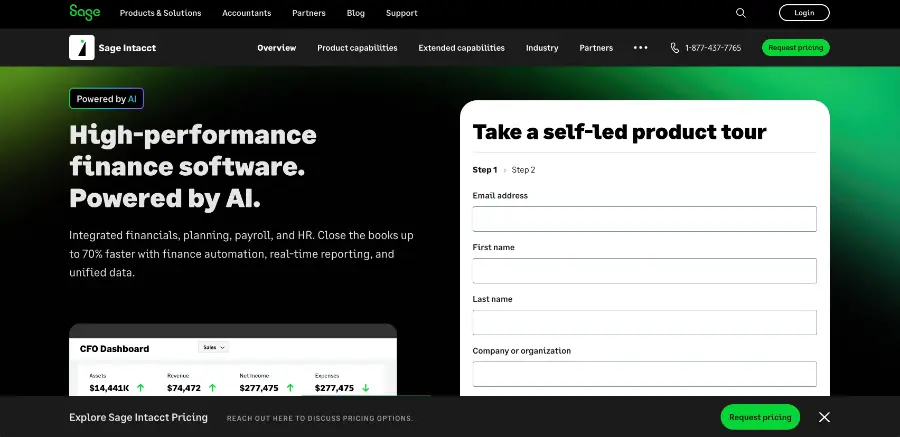
G2 Rating: 4.3/5 (3,951)
Sage Intacct’s revenue recognition is embedded in its cloud financials suite. It’s built to work hand in hand with order entry, billing, and contract management.
When you configure a contract in Intacct, the system can automatically generate a revenue recognition schedule. It supports straight-line, usage-based, and hybrid recognition methods, even decoupled from billing frequency.
If your contract changes mid-term – for example, if a discount’s added or usage shifts – Intacct will reallocate the revenue, sometimes even retroactively into closed periods.
Intacct also gives you visibility across revenue, deferred balances, contract liabilities, and related expenses, with dashboards and reporting by contract, entity, or product line.
Key Features
- Automated handling of ASC 606 / IFRS 15 compliance via templates and schedules
- Support for multiple recognition methods (e.g. straight-line; usage-based)
- Revenue reallocation on contract changes, including retroactive adjustments
- Decoupling of billing and revenue recognition logic
- Integration with CRM systems (e.g. Salesforce) to sync order, contract, and revenue data
- Dashboards and reporting for deferred vs recognized revenue by multiple dimensions
- Expense amortization that can align (or not) with revenue schedules
Pros
- Revenue recognition’s treated as part of the core financial system, not a bolt-on
- Support for contract modifications, multiple recognition methods, and reallocation logic
- Dashboards and contract-level detail help you track what’s recognized, deferred, or at risk
- A strong ecosystem that works well with CRM, order systems, and the rest of your finance stack
Cons / Risks
- Complexity is high. Getting the reallocation logic, contract change handling, and templates right means careful setup is needed
- It’s overkill for simpler companies – if your contracts are basic, you may never use much of the feature set
- Integration and configuration often require experienced resources
Pricing
Sage Intacct uses custom pricing based on modules, contract complexity, and company scale.
7. Salesforce Revenue Cloud
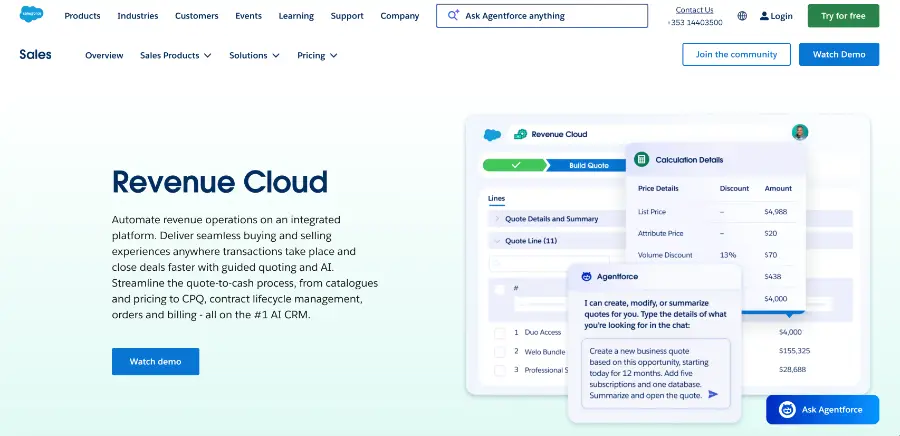
G2 Rating: 4.2/5 (1,426)
Revenue Cloud is Salesforce’s full quote-to-revenue solution. It layers CPQ, contract lifecycle management, billing, order management, and revenue logic on top of the Salesforce CRM backbone.
Once a deal is in the system, Revenue Cloud handles quoting, converts to contracts, issues invoices, and routes order data downstream. Its architecture lets you decouple billing from revenue recognition, letting recognition follow rules rather than billing frequency.
If contract terms shift mid-cycle, the platform updates schedules to make sure accounting stays in sync.
Key Features
- Seamless integration with Salesforce CRM and CPQ modules
- Contract lifecycle and order management built-in
- Flexible pricing and product configuration, discounting, bundling
- Decoupled recognition logic (billing does not force recognition timing)
- Multi-currency and global business support
- Dashboards, analytics, and visibility across quote-to-cash flows
Pros
- Deep alignment with sales and CRM. Data flows without gaps
- A rich feature set across the revenue lifecycle
- Strong automation in quoting, order conversion, and billing
- Visibility and reporting across the pipeline and revenue cycles
Cons / Risks
- There’s a complex setup and steep learning curve – mastering it takes time
- Customizations often require advanced technical resources
- Cost can escalate quickly for smaller or mid-market teams due to licensing and features
Pricing
Salesforce Revenue Cloud pricing is custom and depends on modules, user counts, and usage.
8. AccountingSeed
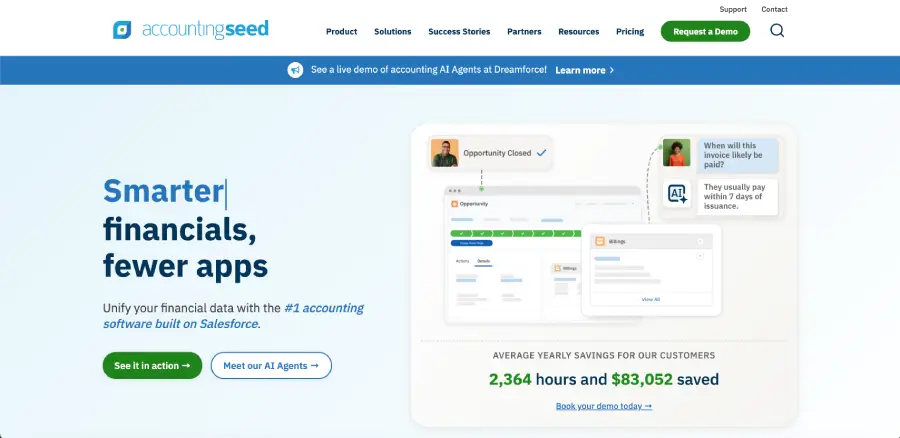
G2 Rating: 4.2/5 (164)
AccountingSeed is a native accounting and ERP system built on Salesforce.
It brings together billing, revenue recognition, project accounting, and general ledger inside the Salesforce ecosystem, removing any data silos between CRM and finance.
When a contract or subscription is entered, AccountingSeed uses configured recognition rules to schedule revenue over time.
It supports multiple recognition methods (straight-line, usage, hybrid) and lets you handle contract modifications and reallocation logic.
The platform also keeps a revenue subledger showing deferred vs recognized balances, tracks contract liabilities, and provides dashboards to slice financials by contract, entity, or product line.
Key Features
- Recognition rules capability (automated scheduling)
- Multi-entity and multi-currency support via native accounting and consolidation features
- Deep Salesforce integration
- Project and contract accounting tied into revenue logic
- Audit trail, journal entry automation, and dimensional tagging
Pros
- Seamless data flow between Salesforce and accounting reduces integration overhead
- Strong flexibility: you can customize workflows, fields, and recognition logic inside the Salesforce platform
- Real-time visibility into financials, contract metrics, deferred balances
- Good support and ecosystem, especially for companies already invested in Salesforce
Cons / Risks
- The learning curve can be steep if your team’s not familiar with Salesforce architecture
- Heavily customizing recognition logic requires technical work and governance
- For very complex billing models, you may hit configuration limits or need custom extensions
Pricing
AccountingSeed uses a tiered subscription pricing model that depends on users, functionality, and complexity.
9. NetSuite (Revenue Management)
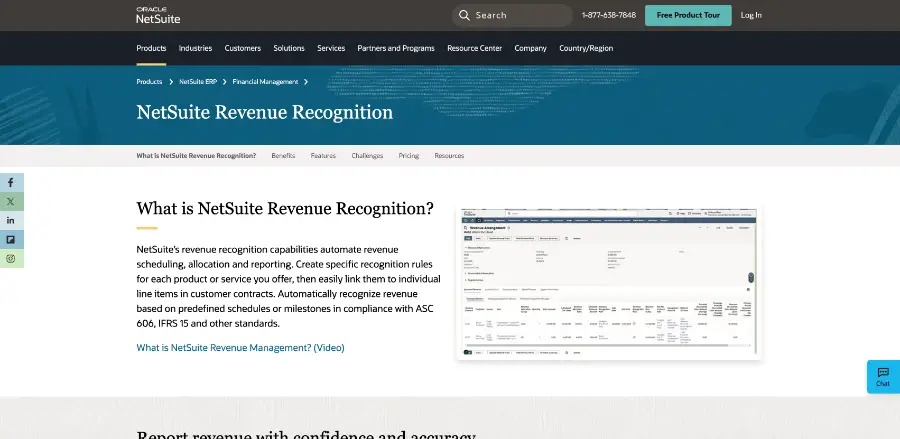
G2 Rating: 4.1/5 (4,065)
NetSuite offers built-in revenue recognition capabilities through its Advanced Revenue Management module. That means you don’t have to bolt something on – it works inside the ERP environment you already use.
When you set up a contract, NetSuite lets you define revenue recognition rules per product or service line. It supports multiple methods: straight-line, milestone, usage-based, and even hybrid models.
If contract terms change mid-term, NetSuite allows you to modify recognition schedules either prospectively or retrospectively.
During the close, the system generates revenue recognition journal entries based on those schedules, deferring revenue where needed and recognizing it as performance obligations are met.
Key Features
- Automated revenue allocation and scheduling for ASC 606 / IFRS 15 compliance
- Rule-based recognition: choose triggers, offsets, and recognition timing per product or contract
- Support for contract modifications, reallocation, clawbacks, and catch-up adjustments
- Decoupling of billing and recognition: revenue logic doesn’t have to follow invoicing cadence
- Real-time visibility into committed, deferred, and recognized revenue
- Multi-entity and multi-currency ready, with OneWorld support to scale globally
Pros
- Revenue recognition lives natively inside the broader ERP, meaning you have fewer silos, less integration complexity
- Flexibility in handling mixed contract types and mid-term changes
- Strong compliance support with built-in control logic
- Visibility and standard reporting across revenue stream stages
Cons / Risks
- Configuration is complex; you need strong finance/ERP expertise to set rules properly
- It’s overkill for simpler use cases – if your contracts are basic, you may never tap full capability
- Modifying recognition schedules retroactively can introduce audit complexity if not managed carefully
- If you’re not already using NetSuite, implementation is expensive and can take months – sometimes up to a year – to complete
Pricing
NetSuite’s revenue recognition module is an add-on, priced based on your core license, modules, and scale.
10. Workday (Financial Management / Revenue)
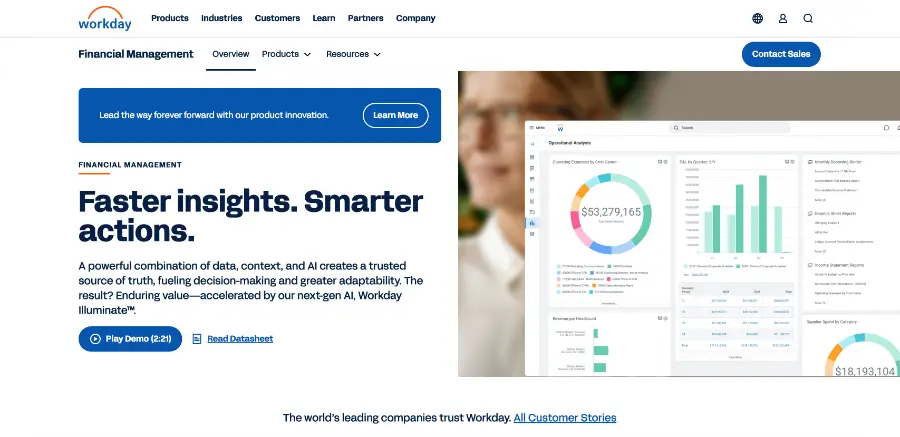
G2 Rating: 4.1 (213)
Workday’s Financial Management suite adds revenue and contract capabilities inside an AI-powered core platform. It positions revenue recognition as a native part of accounting rather than a separate module.
When contracts come in, Workday’s Revenue Contract Agent can extract data from documents, categorize obligations, and feed the system with insights. The platform uses AI agents to detect outliers and suggest entries.
Workday enables recognition logic that is decoupled from billing events – recognition is based on when performance obligations are met, not necessarily when invoices hit. It also supports adjusting schedules if contracts change midstream.
Key Features
- Contract intelligence: automatic extraction of key terms from agreements
- AI agents for anomaly detection, audit readiness, and control validation
- Decoupled recognition logic: recognition timing driven by performance, not invoices
- Adjustment support: handle amendments, usage shifts, discounts mid-term
- Full integration with core finance, ledger, and reporting capabilities
- Embedded controls, continuous auditing, and visibility layers
Pros
- Revenue and accounting live under the same platform, keeping workflows unified
- Advanced AI-driven tools for detection and recommendation reduce manual overhead
- Flexibility when contracts shift mid-course without breaking accounting logic
- Strong audit and control posture baked into the platform
Cons / Risks
- Implementation and configuration can be heavy
- There’s a steep learning curve, especially for teams new to AI-driven accounting
- For simpler contracts or smaller organizations, many capabilities will probably remain unused
Pricing
Workday’s revenue and financial modules are packaged into its enterprise licensing.
11. Recurly Revenue Recognition
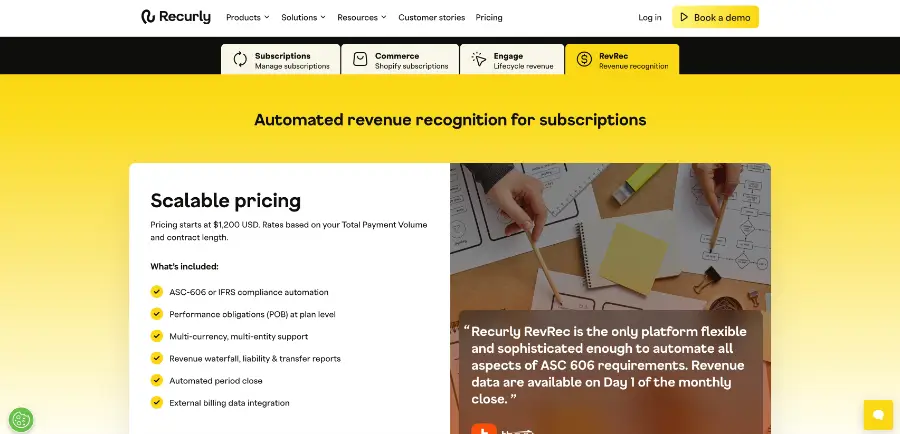
G2 Rating: 4.0/5 (191)
Recurly has built revenue recognition into its subscription platform – it’s not an afterthought. Once contracts land in the system, Recurly applies revenue rules, automates journal entries, and keeps billing and recognition aligned.
It supports multiple recognition models (usage, straight-line, milestone, hybrid), handles contract modifications, and recalibrates schedules when terms shift mid-stream.
Under the hood, Recurly maintains a revenue subledger with deferred vs recognized balances, tracks contract liabilities, and produces built-in reports like revenue waterfall, liability balances, and transfer accounting.
Key Features
- Automates ASC 606 / IFRS 15 compliance within the billing system
- Multiple recognition models (usage, hybrid, straight-line)
- Support for contract modifications, discounts, upgrades, etc.
- Revenue subledger with deferred vs recognized, contract liability visibility
- Built-in reports: revenue waterfall, liability balance, transfer accounting
- Multi-currency, multi-book, multi-entity support in advanced edition
- Integration paths to ERP/GL systems for recognized revenue syncing
Pros
- Tight coupling with subscription/billing reduces friction and handoffs
- Good flexibility in handling term changes, usage, discounts
- Strong reporting out-of-the-box for deferred vs recognized balances
- Enterprise scale: handles high volumes, global operations
Cons / Risks
- Some advanced features (multi-book, multi-entity) require “Advanced” edition or higher tier
- Because it’s built on top of billing, messy billing logic upstream can complicate recognition
- Complex setups or highly customized revenue rules may demand configuration effort
Pricing
Recurly offers custom pricing for its revenue recognition modules based on contract volume and feature tiers.
12. Rillet
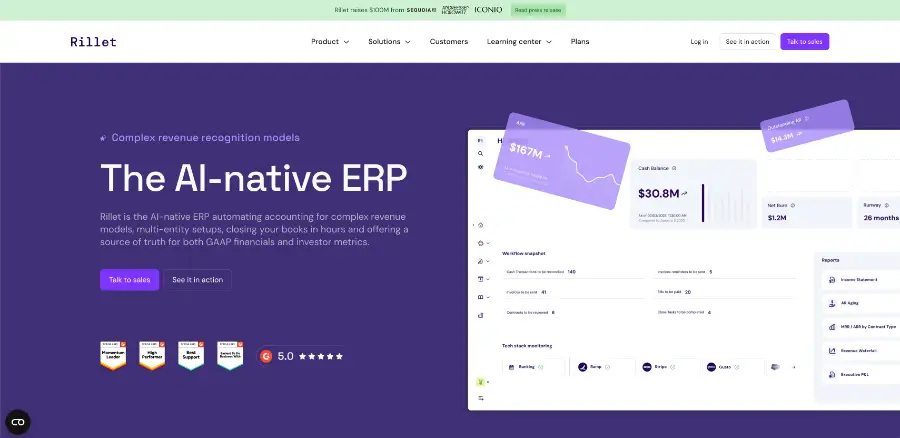
G2 Rating: 5.0/5 (63)
Rillet is an AI ERP system built to handle complex revenue recognition, multi-entity accounting, and real-time financial management from day one.
When contracts sync from your CRM, Rillet generates revenue recognition patterns, posts journal entries, and feeds everything into the general ledger automatically. It supports flat rate, usage-based, and milestone pricing out of the box, and adapts when contracts change midstream.
Behind the scenes, Rillet maintains a full revenue subledger: deferred vs recognized balances, waterfall schedules, and contract liabilities. All adjustments – usage spikes, amendments, credits – flow through and update your financials continuously.
Key Features
- Fully automated revenue recognition (ASC 606 / IFRS 15) built in
- Native contract + CRM integration (syncing closed-deal data for recognition)
- Support for flat, usage, milestone, hybrid models
- Real-time revenue waterfalls and deferred revenue schedules
- Full audit trail linking recognition entries back to contracts
- Multi-entity, multi-currency, and consolidation support
- AI-driven close management, reconciliations, and investor/GAAP reporting
Pros
- Automates around 93% of journals and invoices, cutting down on manual work
- Connects across CRM, payments, banking, and tax systems
- Implementation measured in weeks, not the long cycles of legacy ERPs
- Every entry carries an audit trail, making compliance checks easier
Cons / Risks
- As a newer platform, some integrations or workflows may still need fine-tuning
- Highly complex customized billing logic might push the boundaries of out-of-box capabilities
- Larger enterprises with deeply entrenched legacy systems may face migration challenges
Pricing
Rillet uses custom pricing based on company size, contract complexity, and number of entities.
13. Campfire (MeetCampfire)
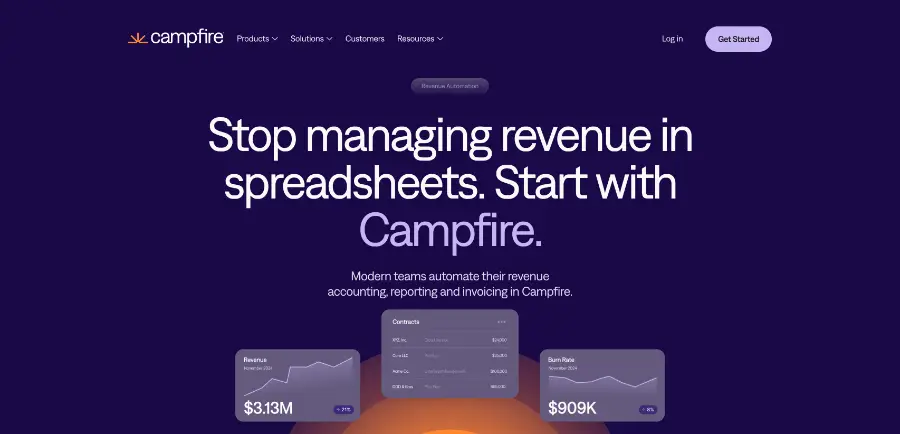
G2 Rating: 4.9/5 (17)
Campfire offers a modern accounting and revenue automation platform for tech and growth-stage companies. It blends core accounting functionality (GL, subledgers, reconciliations) with revenue recognition automation to create a unified, audit-ready system.
When contracts or subscription events enter the system, Campfire parses them, builds schedules, and generates journal entries automatically. It supports multiple revenue types (subscription, usage, milestone, hybrid) and can recalculate recognition schedules when contract terms shift mid-term.
Behind the scenes, Campfire maintains a revenue hub: deferred vs recognized balances, contract performance visibility, and KPI dashboards (waterfalls, recognition schedules) all flow into the platform.
Key Features
- Core accounting (customizable chart of accounts, GL, trial balance, AR/AP subledgers)
- Revenue recognition (allocation, scheduling, reclassification, compliance)
- Multi-entity, multi-currency consolidation support
- Automated close tools, reconciliation, locked periods, audit trails
- AI-assist features (e.g. Ember) to help with journal drafting, variance analysis, and commentary generation
- Integrations (API-based, connects to billing, contract systems, etc.)
Pros
- Users consistently praise the support (Slack channel, responsiveness)
- The modern, intuitive interface reduces friction for teams coming from spreadsheets or legacy tools
- Implementation and migration are often cited as faster than legacy systems
- Strong visibility into contract-level revenue metrics and clear dashboards
Cons / Risks
- Some users mention this is best suited for technology / subscription models; non-tech use cases (e.g. inventory heavy) may expose gaps
- The system is relatively new – certain niche features or advanced modules may still be evolving
- There might be a learning curve if you’re shifting from a legacy system or a custom accounting setup
Pricing
Campfire offers custom pricing tailored to your transaction volume, complexity, and features.
Legacy ERP Add-Ons vs. Modern Rev Rec Platforms

When finance leaders compare options, the real choice isn’t just ERP vs. standalone software anymore. The line has shifted: it’s now about the difference between legacy ERP add-ons and modern platforms built with revenue recognition at the core.
Legacy ERP add-ons
Older ERPs often bolt revenue recognition on as a module. The advantage of this is that everything stays inside one system, but the downside is rigidity. Rules are hard-coded, changes require consultants, and scaling across entities or billing models usually exposes gaps. Audit prep often still means pulling data into spreadsheets.
Modern rev rec platforms
Newer systems, whether standalone or AI-native ERPs, are designed to treat revenue recognition as a first-class capability. They model subscription, usage, and hybrid contracts out of the box. They update schedules automatically when terms change. And they give real-time visibility into deferred vs. recognized revenue streams without waiting for period-end runs.
How to decide
- If you’re on a legacy ERP and need basic compliance, an add-on might be enough – but you’ll trade flexibility for stability.
- If you expect to scale quickly, experiment with pricing, or run multi-entity operations, modern platforms usually give you more speed and less risk.
The AI-Native Advantage
Instead of teams hard-coding rules and cleaning things up at the end of the period, AI systems read contracts, apply the logic, and keep schedules updated as things change.
Auto-tagging obligations: Modern platforms can pull performance obligations straight from contract language. That saves finance teams from digging through line items and re-keying details by hand.
Dynamic revenue waterfalls: Recognition schedules adjust automatically when terms change, usage shifts, or amendments are added.
Disclosure packs on demand: Required reports for ASC 606 and IFRS 15 are generated continuously, not stitched together at quarter-end.
Unlike tools that bolt revenue recognition onto billing or legacy ERP modules, DualEntry was built as AI-first, meaning faster close cycles, audit readiness by default, and far less manual intervention. [10]
How DualEntry Compares

When finance teams stack up their options, the difference is clear:
- An AI-native ERP, not a bolt-on: Revenue recognition is built into the core ledger and workflows
- Real-time allocation: DualEntry handles multi-entity setups, FX translation, and disclosure reporting seamlessly
- Built for scale and leaner teams: It’s designed for lean teams that need IPO-level controls long before they have IPO-level headcount.
Schedule a demo to see how DualEntry runs revenue recognition alongside the rest of your finance stack.
Best Revenue Recognition Software FAQs
Key Takeaways
Automation in revenue recognition matters because manual work doesn’t scale, and legacy tools can only take you so far. Putting rev rec workflows on autopilot, applying the rules across multiple entities, subscription models, and usage-based billing, takes the pain and complexity out of the process.
Legacy systems still work, but the future is AI-native. That’s why we built DualEntry.
.jpg)


